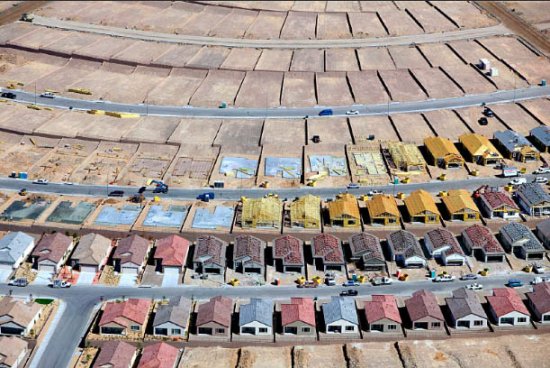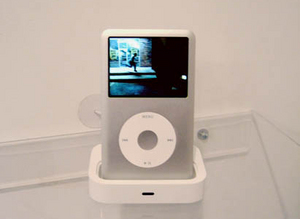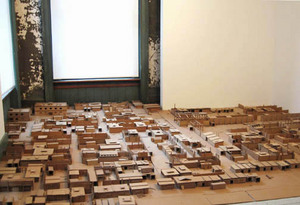This is an archive of the ArtCat Zine, 2007-2009. Please visit our new project, IDIOM.
Market Forces: Consuming Territories

Market Forces Part I (of II): Consuming Territories
At Carriage Trade Gallery through Sunday, May 18th.
5 April - 18 May 2008
Note: Part two of this exhibition will be on view from 23 May - 9 June 2008.
Artist lofts. Think about that term for a second. When was the last time you saw an artist buy an artist loft apartment?
Walk down any block in New York, and you'll understand. No matter the developer or ad agency responsible, there it is on the scaffolding of another high rise: "Luxury artist lofts." Taking a moment to deliberate, one has to wonder if there is anything out there to purchase but luxury.
Just recently installed at Carriage Trade gallery in Soho, Market Forces Part I: Consuming Territories is a poignant commentary on how these words of commerce have been taken out of their historic confines and assigned radical new meaning. Today, artist lofts rarely house working artists, but are deliberately marketed to give the look and feel of bohemian grottoes. Add to it the redefinition of art itself – no longer a vessel of human creation or transference of beauty; there is nothing left to ponder, but only to possess. In the Market Forces exhibition, we're asked to consider if we are, or have ever been, truly free? This show serves as a cautionary tale of the present day voracious societal norm of living beyond one's means, and a harbinger of further devolution still to come.
With the completion of Manifest Destiny, growth has now turned inwards. An obliteration has occurred – yards, trees, sidewalks, being able to walk to school. Much of what was once commonplace in communities has forever vanished before our eyes. Take Alex MacLean's almost Google Earth-like aerial photographs of planned communities in various stages of development. Appearing almost like a crowded cookie sheet, or container of Marshmallow Peeps, each home is meticulously spaced just feet apart from the next. In the photo of Las Vegas, they look as if they're being built close enough for a resident to open a window and shake a neighbor's hand. An Orwellian story come to life, these planned communities give up any sense of uniqueness to the design of the home itself. There is no room for eccentricity, let alone individuality. At the same time, despite that these designs are carbon copies of each other, the cookie cutter offerings are nonetheless marketed to the buyer as "theirs to own." Viewing the desolate plots of desert land and cloned candy-shell roofs from above shows how hollow the promise rings. The continued notion of home ownership is incredibly deceitful, for no one is truly a homeowner unless they have paid every cent of the cost. MacLean is not only warning the viewer of a loss of self, but also highlights the downfall of a credit-based society lying dormant and complacent, sleeping in their 300-thread count sheets, happily sedated by their Lunesta, snoring away, all the while believing the lie. This photo in particular shows the harsh reality. The modern day lords of the land (the banks) are the real owners — a singular image of the new feudalism.

In Gretchen Bender's Selling Cars, we're bombarded by rapid edits from Fox's never-ending series COPS juxtaposed alongside SUV commercials. Bender challenges the viewer on this point: "Is bigger always better?" With the current price oil, the SUV may soon be going the way of the Ford Pinto. But Bender's rapid video, only 17 seconds in length, shows that gluttony knows no bounds, for society continues its love for the highway, choosing a full tank of gas over a good meal. And at such a quick viewing speed, the artist gives a subtle nudge at Americans' ever-shrinking attention span. I walked away from the video iPod feeling quite discombobulated, with a desire to buy a can of mace and go to my nearest Jeep dealer for a test drive.
Ever increasingly, and in New York in particular, we're witnessing the demolition of entire neighborhoods and their history, replaced with glass and brick towers looking more SoFlo (South Florida) than LES. Diane Nerwen's Open House, Chapter 1: Removal focuses almost exclusively on the gentrification of Brooklyn's Williamsburg neighborhood. In the video you see home after home destroyed, making way for the new. Only the plywood walls cordoning off the vacant lots remain. Voices of area realtors narrate: "There's still 95% financing available for qualified buyers," with "full amenities." "You just can't pass this deal up," one emphatically states. Nerwen shows that in just a few years' time, a neighborhood that was almost exclusively blue-collar residential has transformed into a haven for white-collar ambiance chasers, often from way out of town. In several of her edits the images of smashed roofs from tiny frame houses gobbled up by eager developers are prominent. They lie exposed in their fragility to the elements not unlike the ruins of a tornado's aftermath. A solitary chair juts out upon the horizon, awaiting the wrecking ball's final blow. The most powerful line in the work comes from a long-time resident who refuses to sell. After being offered a mere $500,000 for her property, she states, "I can't afford to sell. Where would I go?" Nerwen might give a nod here that this is a losing battle, but exposes the profiteers for who and what they are – usurpers guiltlessly cashing their checks on the plights of the unfortunate.
Seeing Betty Beaumont's astonishingly bleak photographs of foreclosed properties in Dorchester, MA, was also particularly painful. In her work Subprime America, echoes of Gordon Gekko's "Greed is good" lives on, for unfortunately, this is not a catchphrase that died with the 1980s. Beaumont is keenly aware that the American populace doesn't react until the story is in their own backyard. Once the bank has started foreclosure proceedings there is no turning back, for it not only affects the homeowner, but the surrounding community. Property values nosedive, and we're increasingly seeing foreclosures grouped into neighborhood clusters, taking into account the purchasing power of get-rich-quick-scheme investors winning easy approval when the going was good. The boarded up windows of the triple-deckers tell the tale of how parties on both sides have changed America, for each fed off the other getting a short-term solution to their wants, which were perceived as a need. In one corner, we have people living beyond their means, in the hopes of living the ever elusive "American Dream," and in the other we have individuals operating with full knowledge that that very dream is a sham, and did everything in their power to put their own profits ahead of their client's best interests. Some very powerful pieces indeed.
Throughout Market Forces a key element keeps reappearing on how consumerism is driving us to abandon. Keeping up with the Joneses has been replaced with Keeping up with the Ty Pennington's. In fact, a disturbing element of "Extreme Makeover: Home Edition" is not only the McMansion that replaces the lower-middle class home that once was, but the rabid cheering that takes place upon the arrival of the bulldozer. "Tear that thing down," they scream. No longer content with the Sears catalog, today it takes a $5,000 custom-made refrigerator to put us in step with our neighbors.

Michael Ashkin's impressive all cardboard installation, Hiding places are many, escape only one conveys just the opposite. An almost Lilliputian shantytown, this could double as the streets of East L.A., or Halsey Street in Bushwick. The town has no boundaries, or centrality. The disjointedness is similar to the maze we now find ourselves in. Multi-million dollar condos are literally being built next door to public housing projects. Ashkin's work here is astonishingly poignant. There is no delineation of separate neighborhoods, because the very concept of a neighborhood is disappearing.
In January of 2001 the United States Army came up with a new slogan. No longer satisfied with "Be all that you can be," they launched "An army of one." As one of the more unpopular ad campaigns in history, it touted the individual over teamwork. In much the same way, Momoyo Torimitsu's video Horizons (Mini-Businessmen), shows the suits from Asia, Europe and the U.S. crawling along in basic training formation. Toppling skyscrapers, oil tanks, and any other thing that gets in their path they march onwards in their quest for more, ever more. Appearing almost ant-like in formation, their bellies drag on the ground, feet clumsily limping behind. For each of these obedient little foot soldiers are a cog in the machine, working for the perceived common good – the advancement of wealth. Each does their best to tow the line. Interestingly enough, the hands of each of the soldiers are sealed in a cocked grasp, as if they were clutching a rifle – or more likely, in this case, an iPhone.
Much in the same way as Torimitsu's Armani-clad foot soldiers show they are an army of one, so too, are we as a society. Even the artists in this exhibition play a part in the "Market Rate" machine. They are saying very important things collectively, but again, it's one-sided. There's certainly the safety in numbers factor, and even though I personally agree with almost 100% of the tone of this exhibit, the lack of a differing viewpoint is a bit troubling nonetheless. Perhaps human fallibility is not being understood deeply enough, for each and every one of us in corruptible, no matter the initial good intentions. For as we see in Peter Scott's telling photo of a billboard advertising Ian Schrager's 40 Bond Street condo, a jealous twinge absorbs into our psyche. Faced with a direct visual of how the other half lives, it's temptation at its finest, but it's up to us to decide whether to eat it up or spit it out.
ZINE
HOME
TIPS / COMMENTS
CATEGORIES
CONTRIBUTORS
- Greg Afinogenov
- B. Blagojevic
- Adda Birnir
- Susannah Edelbaum
- Julie Fishkin
- Paddy Johnson
- Jessica Loudis
- Christopher Reiger
- Andrew Robinson
- Peter J. Russo
- Blythe Sheldon
- S.C.Squibb
- Hrag Vartanian
